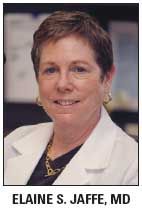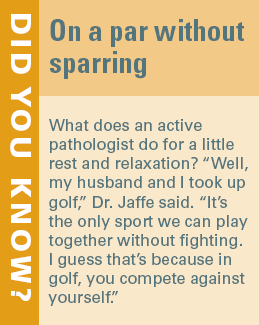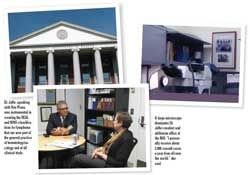Elaine Jaffe: At the forefront of clinical lymphoma biology
The modest, utilitarian office of Elaine S. Jaffe, MD, is dominated by a large microscope, stacks of pathology slides, and a view of the sprawling, 350-acre campus of the National Institutes of Health.
ABSTRACT: After decades, she remains dedicated to pathology diagnosis
The modest, utilitarian office of Elaine S. Jaffe, MD, is dominated by a large microscope, stacks of pathology slides, and a view of the sprawling, 350-acre campus of the National Institutes of Health.

“After 37 years at NIH, I finally got an office with a window,” she said with a laugh. Of course, how much time this chief of hematopathology at the NIH has to enjoy the scenery is another matter. Title aside, Dr. Jaffe is a dedicated working pathologist in an ultra-demanding environment: The NIH supports a large clinical lymphoma research program and Dr. Jaffe’s section reviews all patient biopsies for diagnosis.
“On top of that, I personally receive about 2,000 consult cases a year from all over the world,” she said, pointing to a tower of slides.
After spending some time with Oncology News International, Dr. Jaffe still had slides to read before closing up for the night.
And even when she has time away from the office, her chosen field is not far out of her mind. “I’m going to the opera tonight to see La Traviata,” she said. “Then I have to pack. I’m leaving for France tomorrow.” A well deserved vacation?
“Nope, a pathology conference,” Dr. Jaffe replied.
From rocks to cells
Dr. Jaffe’s parents were part of the waves of Russian Jews fleeing to the U.S. to escape the pogroms. As a young girl growing up in White Plains, N.Y., Dr. Jaffe was drawn to science, although not necessarily to pathology; astronomy and geology held special places in her heart. “I was fascinated by the world around me,” she said.
But it was a biology class that made the science of living beings more alluring than distant galaxies or fossilized rocks. “I fell in love with biology and decided in high school that I was going to become a doctor,” she said. Dr. Jaffe started out at Cornell University in Ithaca, N.Y., and completed her medical education at the University of Pennsylvania in Philadelphia. It was the early 1960s and the feminist movement was gathering steam. But even so, women still rarely ventured into such male-dominated professions as medicine.
“I was one of only five women in a class of more than 100 medical students.” she noted.
Intrigued by medicine
Dr. Jaffe never struggled with the research versus practice conundrum that many medical students face: Her first glimpse of tissues samples under a microscope made medicine come alive for her.
“What drew me to medicine was my fascination with the biology of disease, not an overarching desire to help humanity. Let somebody else do that. I decided to stick with understanding the basis of disease,” she explained.
Dr. Jaffe fell in love one more time during her second year at med school when she met and married her husband, Michael Evan Jaffe, a lawyer-in-training. Her husband graduated from law school, began a clerkship in the Federal District court, and the couple’s first child was born.
As the Vietnam War trudged on, Dr. Jaffe’s family grew and the clan headed for Washington, DC, where she took a residency position at Georgetown University and worked primarily in anatomic pathology.
She recalled that one of her first autopsies was a tough one. The patient had unexplained hypoglycemia and an insulin-producing tumor was suspected.
“I was going over the organs with the faculty and somehow I couldn’t find the pancreas, which was a rather important organ to this patient. And to this day, I don’t know how I lost it,” she recounted. “The pancreas might have been totally destroyed, probably very atrophic, and maybe totally replaced by tumor. It wasn’t as though there was a nice, beautiful pancreas just sitting there that I missed. There may very well have been technical reasons why I had problems identifying it, but still, I felt very badly about it.”
Changing the face of disease
After a year at Georgetown, Dr. Jaffe entered an NCI residency program as the world of cancer therapy was undergoing dramatic changes: In essence, curative chemotherapy was being born.
At the NCI, “they were conducting acute lymphoblastic leukemia protocols in the pediatric oncology group. Remarkably, those patients were actually being cured, there were long-standing remissions, completely changing the face of the disease,” Dr. Jaffe said.
Advances in cancer care are based on incremental gains in knowledge. Dr. Jaffe’s early research at NCI helped replace purely descriptive classifications with those based on immunology, which, in turn, helped in the development process leading to today’s disease-specific therapies.
“Remember, at that time nobody knew which cells generated lymphomas,” she said. “If you looked through the microscope, you wouldn’t know what a T-cell or a B-cell was.”

Dr. Jaffe and her fellow NCI researchers showed that red blood cells coated with antibody and erythrocyte-antibody-complement (EAC) adhered to what they thought were the B-cell areas. Focusing on nodular lymphoma, Dr. Jaffe set out to prove her thesis. “I knew that normal follicles had these complement receptors, so we thought, ‘well, maybe we could prove that nodular lymphoma is derived from follicular B-cells.’ And lo and behold, the red cells coated with EAC stuck to these B-cells, proving they were lymphocytes derived from the lymphoid follicles.”
Dr. Jaffe’s groundbreaking research paper was published in the New England Journal of Medicine. “It became a ‘citation classic,’ which means it was cited a certain number of times. I would say it was a pioneering discovery at the time,” she commented (NEJM 290:813-819, 1974).
Classification confusion finally solved
Dr. Jaffe explained that from the late 1960s through the early 1990s, multiple lymphoma classifications were used throughout the world.

“This lack of consensus on lymphoma classification and terminology caused problems for both pathologists and clinicians, and created diffi culty in interpreting published studies,” she said.
In 1991, Dr. Jaffe and other internationally recognized pathologists were invited to attend the newly formed International Lymphoma Study Group (ILSG), headed by Peter Isaacson, MD. The meeting synergized the classification initiative. “As we discussed lymphomas, we found consensus on most items, so in 1994 we published the REAL classification, which was published in Blood, and actually became the most highly-cited article in all of clinical medicine over the next 10 years,” Dr. Jaffe said.
“We were defining individual disease entities and the clinicians really embraced this. Our classification was then adopted by the World Health Organization, becoming the WHO Classification,” said Dr. Jaffe. The development of the REAL and WHO classifications had a major impact on the field, and are now a part of both the general practice of hematology/ oncology and a part of all clinical trials. “They are the language of patient care and management and impact how patients are treated,” she said.
“Another exciting aspect of my current work is educating young pathologists; sitting across the microscope from them and helping them develop their skills, and then also helping them develop their careers,” Dr. Jaffe said.
On top of her daunting NCI workload, Dr. Jaffe still gets cold calls from patients seeking direct advice about a troubling diagnosis.
“My number is in the (NCI) directory; I never thought about having it unlisted,” she said with a shrug.
When asked whether looking into her microscope still fascinates her, Dr. Jaffe responded, “Absolutely, I still look forward to coming to work every day! I almost regret when I have to leave at night because I know there are things that I’ve left undone, and then I can’t wait to get up in the morning to come in.”
CAREER HIGHLIGHTS
A senior NCI investigator since 1974, Dr. Jaffe has served on the editorial boards of the American Journal of Pathology, the American Journal of Surgical Pathology, Blood, Cancer Research, and Modern Pathology.
She served as president of the Society for Hematopathology and the United States and Canadian Academy of Pathology (USCAP).
In 1993, Dr. Jaffe was elected a fellow of the American Association for the Advancement of Science (AAAS). In 2005 she was chair of the Medical Sciences Section of AAAS.
She is among the 10 most highly cited researchers in clinical medicine for the fi eld of oncology between 1981 and 1998.
In 2007 she was the second Anita Roberts Lecturer at NIH.
Her awards include the Fred W. Stewart Award from Memorial-Sloan Kettering Cancer Center, the Mostofi Award from USCAP, and the Distinguished Clinical Teacher award from the NIH Fellows Committee. Also, Dr. Jaffe was awarded an Honoris Causa from the University of Barcelona in 2008 and received the Chugai Award for Excellence in Mentoring and Scholarship from the American Society of Investigative Pathology.
Dr. Jaffe is a recently elected member of the Institute of Medicine.